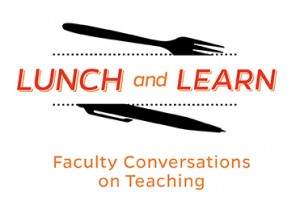 On Thursday, February 15, the Center for Educational Resources (CER) hosted the third Lunch and Learn—Faculty Conversations on Teaching, for the 2017-2018 academic year.
On Thursday, February 15, the Center for Educational Resources (CER) hosted the third Lunch and Learn—Faculty Conversations on Teaching, for the 2017-2018 academic year.
Anne-Elizabeth Brodsky, Senior Lecturer, Expository Writing and Karen Fleming, Professor, Biophysics, presented on Fostering an Inclusive Classroom.
Anne-Elizabeth Brodsky led off by describing the Expository Writing program. [See presentation slides.] Students learn in small class settings (10-15 students) how to write and academic argument using evidence. The academic argument is framed as an ongoing conversation—they say (identifies the problem or viewpoint), I say (recognizes a flaw in the argument and establishes a thesis to correct the flaw), so what? (what’s at stake or what’s next?)—to which the student is contributing. The vast majority of her students are in the STEM fields. This is the background for Brodsky’s introduction of diversity and inclusion in the classroom.
Students bring their complex identities and a sense of whether or not they feel they belong on campus to the classroom. Brodsky seeks to make sure that her curriculum includes reading diverse authors. Students are given a number of choices for each major writing assignment so that they can find something that interests and speaks to them. Additionally, students do informal writing on topics fincluding What is College For? Learning (science of learning, recent research, advice), School (campus life, student realities, ideas for redesign), Stories—why they matter, Words (language change, texting, big data). For each topic area Brodsky identifies a number of articles that students can choose from to read and write a response. She tries to make topics current and relevant, and to be flexible, for example, after the death of Freddie Gray in April 2015, “I offered my students supplemental reading. I hoped to show how the JHU community engaged in local, ‘real-life’ struggles with rigorous, historically responsible, and creative thinking.” She encourages interdisciplinary conversations so that students don’t shut themselves off from possibilities.
Brodsky works with students who are afraid of writing and finds that different approaches work for different students. She is an advocate of Universal Design for Learning (UDL). In the classroom she practices eight ways of teaching.
- Giving students permission to fail successfully. The writing process is all about
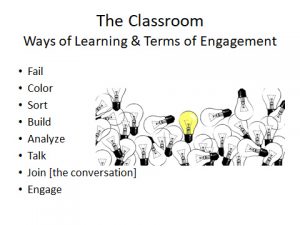 drafts and revisions; students learn that their first efforts may not work well, but they can learn from mistakes and rewrite.
drafts and revisions; students learn that their first efforts may not work well, but they can learn from mistakes and rewrite.
- Using color highlighting while reading, by Brodsky and the students, to understand how an academic argument works.
- Sorting through key words used in an academic argument to understand how language works. For example, when identifying a flaw in an argument, key words are repudiate, contest, reject. Next, Brodsky has students perform textual analysis, by looking at a text and deciding whether it is either a conversation over coffee or actual textual analysis. For example, the text being analyzed is a comment on this quote (taken from a John Oliver segment): “A former British prime minister once described refugees as a “swarm of migrants.” Answer A is: “That made me crazy.” [conversation] Answer B is: “The word ‘swarm’ suggests invasion, threat, as well as equating humans to insects.” [textual analysis]
- Using Lego building blocks with statement taped to the sides, students “build their argument.”
- Learning to analyze and interpret by practicing describing things in different ways.
- Employing different ways of talking and discussing in the classroom. Students prepare elevator talks, engage in think/pair/share activities, anonymously share worries and wishes on index cards, and write questions to establish knowledge.
- Crafting a succinct “elevator pitch” to streamline their own academic argument.
- “What I mean here is to help and expect students to engage fully in their work on campus—not just their science brains for science, or even just their intellectual skills for their courses. Rather, they come here with richness of experience far beyond the academic classroom.”
In engaging students, Brodsky helps them to see frustration as unrealized potential and uncertainty as curiosity. She drew on a 2013 interview with British psychoanalyst and essayist Adam Phillips: “A student who’d been frustrated for weeks by my suggestion that thesis statements were probably not good things to have about works of literature began to recognize that her frustration was partly a fear of freedom. ‘You’re really just increasing my allowance,’ she said.”
By engaging in inclusive teaching practices, Brodsky has given her students the freedom to learn.
Karen Fleming started off by stating her goals for an inclusive classroom: To create a learning environment where everyone feels safe to express ideas and questions, where discussion brings multiple diverse questions and all opinions are considered, and where student experiences of marginalization are minimized. Two of the many challenges that instructors face are unconscious bias and student stereotype threat. [See presentation slides.]
Fleming noted that 99% of our cognitive processing uses unconscious reasoning. Unconscious bias stems from our experiential expectations; bias being an error in decision making. Expectation bias is grounded in stereotypes such as women are not as good at math or spatial learning; Hispanics and African Americans are lower achieving than Whites; Hispanics, African Americans, poor, and obese people are lazy; male athlete are jocks (muscular but not smart); Asians have higher math abilities; and blondes are less intelligent than brunettes. Stereotypes are cultural and both faculty and students have biases.
Fleming described a research study on science faculty and unconscious bias [Moss-Racusin et al. (2012) “Science faculty’s subtle gender biases favor male students” PNAS 109: 16474-79.] The study was headed by Jo Handlesman, Professor, Department of Molecular, Cellular & Developmental Biology, Yale University. Fleming walked through the study details, noting that the institutions selected—research intensive universities—were geographically diverse, the demographics on faculty participants agree with national averages, and it was a randomized double-blind study (n = 127). Science faculty in biology, physics, and chemistry were asked to rate the application of a student for a lab manager position in terms of competency and hireability. Faculty participants were randomly assigned an application with a male or female name—the applications were otherwise identical and designed to reflect high but not outstanding qualifications.
Both male and female faculty participants showed gender bias by rating the male applicant as significantly more competent and hireable than the female applicant. They were willing to offer a significantly higher starting salary (and more career mentoring) to the male applicant. And, perhaps surprisingly to women in the audience, both female and male faculty were equally likely to show gender bias favoring male applicants and to offer the female candidates a lower salary. One possible explanation? Male stereotypes meet the expectation for the lab manager position.
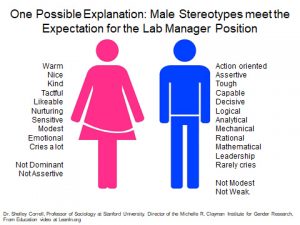 Expectation bias occurs when we hold different groups accountable to different standards. When a man performs well in a traditional male-type task, this performance is expected. When a woman performs well in a traditional male-type task, this conflicts with stereotypic expectations. As a result, her performance is closely scrutinized, and she is required to repeatedly prove her competence.
Expectation bias occurs when we hold different groups accountable to different standards. When a man performs well in a traditional male-type task, this performance is expected. When a woman performs well in a traditional male-type task, this conflicts with stereotypic expectations. As a result, her performance is closely scrutinized, and she is required to repeatedly prove her competence.
We can check our biases using tests set up by Project Implicit. “Project Implicit is a non-profit organization and international collaboration between researchers who are interested in implicit social cognition – thoughts and feelings outside of conscious awareness and control. The goal of the organization is to educate the public about hidden biases and to provide a ‘virtual laboratory’ for collecting data on the Internet.” Look for tests on bias concerning gender, race, religion, disability, age, sexuality, weight, skin tone, and more in the Social Attitudes section.
Fleming then discussed the issue of stereotype threat. For students, performance in academic contexts can be harmed by the awareness that one’s behavior might be viewed through the lens of stereotypes. And, culturally-shared stereotypes suggesting poor performance of certain groups can disrupt performance of an individual who identifies with that group. She referenced a study done by Steele and Aronson in 1995 [CM Steele and J Aronson (1995) Journal of Personality and Social Psychology 69: 797-811.] At Stanford, 114 undergraduate students volunteered for the study. They were given a test composed of Verbal GRE questions. First they took a test that was presented as diagnostic, a measure of intrinsic ability, and then a test presented as non-diagnostic, a laboratory tool for studying problem solving. The results showed that invoking stereotype threat (diagnostic test) affects performance of students who identified as African-Americans in an evaluation setting. Further, having to identify their race before taking the test, “race-priming,” increases the results of stereotype effect on performance in an evaluation setting.
How can instructors be more inclusive? Fleming offers these suggestions.
- Establish a Growth Mindset
- Set clear, equal and high but achievable expectations for all students
- Include material created by people of different backgrounds
- Pay attention to group dynamics (especially compositions of small groups).
As both Fleming and Brodsky reminded the audience, instructors can change the way they teach to be more inclusive, identify their biases, and work to establish a positive classroom climate.
Macie Hall, Senior Instructional Designer
Center for Educational Resources
Image Sources: Lunch and Learn Logo (© CER), slides from Brodsky and Fleming presentations
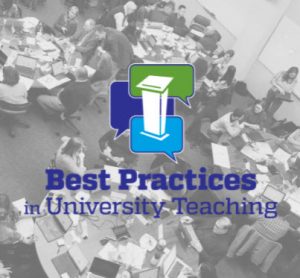 One of the many sessions that generated a great deal of discussion was the Inclusive Pedagogy session, which addressed the importance of accommodating the needs of diverse learners in a supportive environment. The session was led by Dr. Karen Fleming, a professor in the Biophysics department who is also nationally recognized for her efforts in raising awareness on overcoming biases and barriers to women in STEM. I played a small role in the presentation by providing a brief introduction and overview of Universal Design for Learning (UDL), a research-based educational framework that helps remove unnecessary barriers from the learning process.
One of the many sessions that generated a great deal of discussion was the Inclusive Pedagogy session, which addressed the importance of accommodating the needs of diverse learners in a supportive environment. The session was led by Dr. Karen Fleming, a professor in the Biophysics department who is also nationally recognized for her efforts in raising awareness on overcoming biases and barriers to women in STEM. I played a small role in the presentation by providing a brief introduction and overview of Universal Design for Learning (UDL), a research-based educational framework that helps remove unnecessary barriers from the learning process.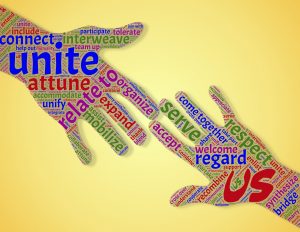 As a culminating exercise, we asked participants to consider the principles of UDL as well as ideas and discussions from earlier in the session to complete an “Inclusive Strategies Worksheet;” the worksheet would contain concrete strategies that would make a measurable difference in terms of inclusivity in their classrooms. The participants were very thoughtful in their responses and several of their ideas are worth sharing:
As a culminating exercise, we asked participants to consider the principles of UDL as well as ideas and discussions from earlier in the session to complete an “Inclusive Strategies Worksheet;” the worksheet would contain concrete strategies that would make a measurable difference in terms of inclusivity in their classrooms. The participants were very thoughtful in their responses and several of their ideas are worth sharing:




